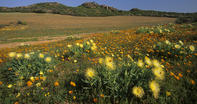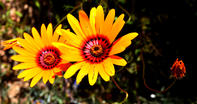Delights for Nature Lovers
The marginal semi-desert areas of Namaqualand are all potentially rich grasslands, but they cannot recover from overuse during regular dry periods, during which, in times past, the people would move off the land and give it time to recover.

Even the annual spring shower of daisies that lights up the fields of Namaqualand is a spectacle that every year delights nature lovers, but it owes its brilliance in part to the degraded veld. These ephemeral flowers are designed to take advantage of transient conditions in marginal areas. Although they would naturally be there to bloom after the first rains of spring, when the land is disturbed they flourish as the first stage in recovering the natural climax vegetation.
Most of the flowers that set Namaqualand ablaze in springtime belong to the family Asteraceae, which is one of the largest flowering families on earth and includes the gazanias ('gousblomme'), ursinias (marigolds), Euryops genus (including the Clanwilliam daisy) and everlastings (Helichrysum sp.) which are more common in the Fynbos Biome and Afro-montane highlands.
To the west the land changes from Namaqualand's scrub semi-desert to the southern Kalahari, which consists almost entirely of dune sands covered by Stipagrostis and similar sweet grasses and open acacia savanna. The Nossob and Auob are the two largest rivers of the southern Kalahari and although they stand dry for most of the year, like the rivers of the Namib, they are vital arteries of the land.
Breathtaking Profusion

Flowers such as Gazania lichtensteini appear in breathtaking profusion as a direct result of overgrazing. Their biological role is to help regenerate the tired veld and is the first step in plant succession. This succession tends towards a shrub-dominated flora, but in vain, for overgrazing is resumed as soon as the spring flowers show.
Although Namaqualand's flora exhibits several intriguing features to botanists, the main attraction for most people is the annual magnificent display of spring flowers. The family Mesembryanthemaceae, has over 2 000 recorded species and this list is probably not yet complete.
An unexplained phenomenon, which intrigues botanists is the profusion and seemingly endless array of small succulent plant species on the Cape's north-western coast. Certain families of plants contain numerous species with complex relationships, which will take botanical taxonomists many years to unravel. The stapelias, such as Hoodia gordonii, have evolved some of the most interesting reproductive architectures in the plant kingdom.
Most of the flowers are large and fleshy, giving off a heavy foetid odour that attracts pollinating insects. The pollen is formed in two sacs with a connecting bridge which looks like a yolk. The bags attach themselves to the legs of insects and are then transported to other flowers of the same species, where they slot perfectly into the stigmatic grooves. The pollen bags and stigmas of each species have a precise key-and-lock fit.
Did you know! The springtime flowering spectacle that bursts out across the arid Namaqualand plains each year is, ironically, a measure of the area's environmental degradation. Although they would occur naturally, these plants act as pioneer species; where overgrazing is worst, the annual bloom will be most impressive, especially when the winter rains have been good.
By David Bristow